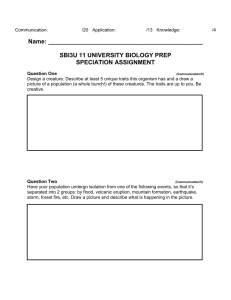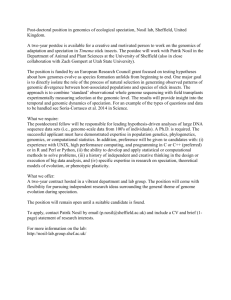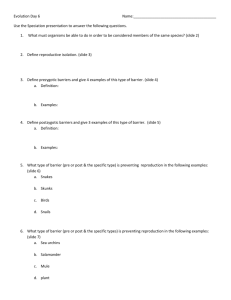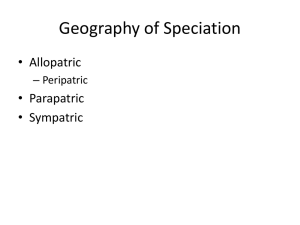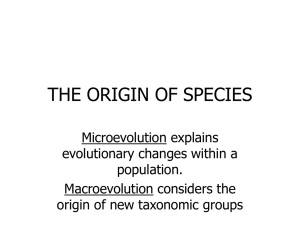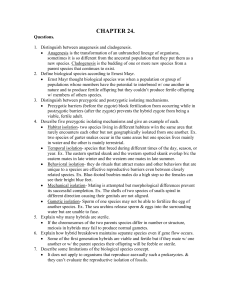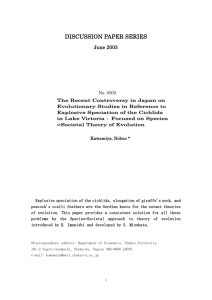Chapter 24 Study Guide
advertisement
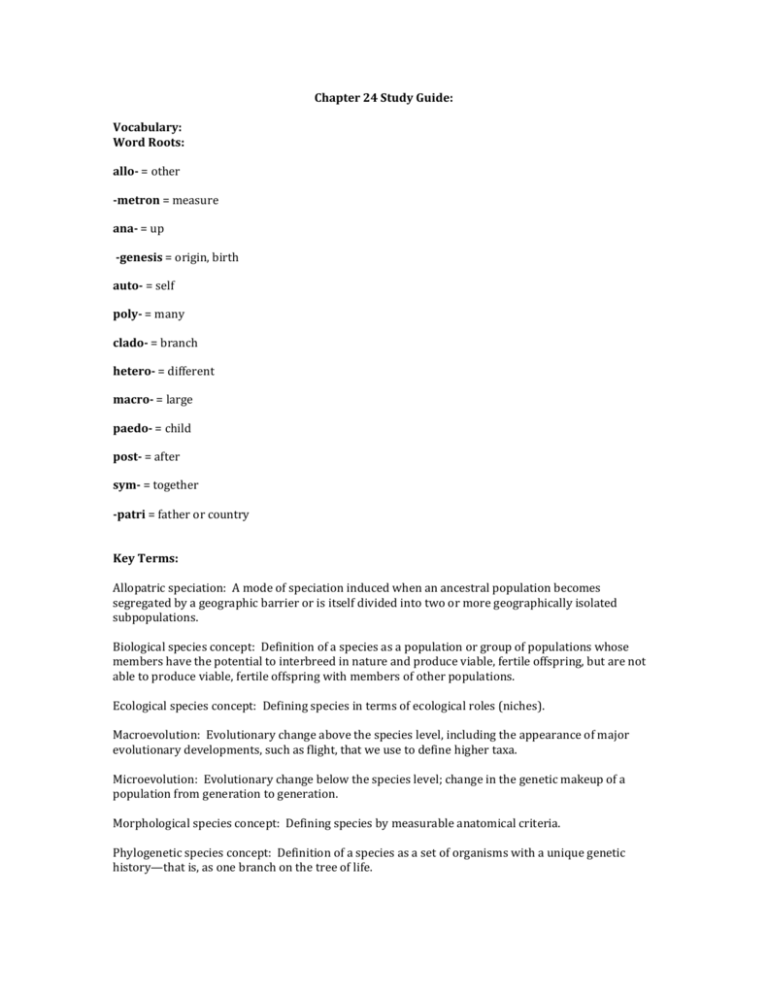
Chapter 24 Study Guide: Vocabulary: Word Roots: allo- = other -metron = measure ana- = up -genesis = origin, birth auto- = self poly- = many clado- = branch hetero- = different macro- = large paedo- = child post- = after sym- = together -patri = father or country Key Terms: Allopatric speciation: A mode of speciation induced when an ancestral population becomes segregated by a geographic barrier or is itself divided into two or more geographically isolated subpopulations. Biological species concept: Definition of a species as a population or group of populations whose members have the potential to interbreed in nature and produce viable, fertile offspring, but are not able to produce viable, fertile offspring with members of other populations. Ecological species concept: Defining species in terms of ecological roles (niches). Macroevolution: Evolutionary change above the species level, including the appearance of major evolutionary developments, such as flight, that we use to define higher taxa. Microevolution: Evolutionary change below the species level; change in the genetic makeup of a population from generation to generation. Morphological species concept: Defining species by measurable anatomical criteria. Phylogenetic species concept: Definition of a species as a set of organisms with a unique genetic history—that is, as one branch on the tree of life. Polyploidy: A chromosomal alteration in which the organism possesses more than two complete chromosome sets. Postzygotic barrier: Any of several species-isolating mechanisms that prevent hybrids produced by two different species from developing into viable, fertile adults. Prezygotic barrier: A reproductive barrier that impedes mating between species or hinders fertilization of ova if interspecific mating is attempted. Punctuated equilibrium: In evolutionary theory, long periods of apparent stasis (no change) interrupted by relatively brief periods of sudden change. Speciation: The origin of new species in evolution. Species: A group whose members possess similar anatomical characteristics and have the ability to interbreed. Sympatric speciation: A mode of speciation occurring as a result of a change in the genome of a subpopulation, reproductively isolating the subpopulation from the parent population. Chapter 24 Important Points: New species arise through speciation events driven by various selection pressure One of the most common ways to define a species is using the biological species concept which maintains members of a species must naturally reproduce and produce viable, fertile offspring o There are limitations to the biological species concept so other methods to define species exist Hybrids, in terms of speciation, refers to offspring of 2 different species Reproductive isolation between species can be maintained at many levels o Prezygotic barriers such habitat isolation, timing of mating, mating behavior differences contributing to sexual selection, incompatible mating appendages and gametes that can not combine for chemical or physical reasons o Postzygotic barriers assume a zygote is formed by it may have reduced viability so it does not survive or if it does, it is sterile or subsequent hybrid offspring have reduced viability Speciation can occur with physical, geographical barriers which keeps gene pools separate (allopatric) or by other means even when species are not isolated (sympatric) In sympatric speciation, species may exploit smaller areas of their habitats called ecological niches which can drive differences between populations eventually to the point of speciation or sexual selection may subdivide populations so that eventually this behavioral isolation leads to other reproductive barriers o In plants, duplication of entire sets of chromosomes can lead to polyploidism in which new species have stable, new chromosome numbers compared to original species Hybrid zones exist in the middle ground between where 2 separate species overlap so that mating can take place Different scenarios can develop from hybrid zones o Reinforcement: Original species are selected for and hybrids do not do very well so that the original species continue to diverge o Fusion: Hybrids are very fit and the 2 original species may eventually become one single species o Stability: Original species stay separate but occasional hybrids continue to form in the hybrid zone but don’t increase or decrease in number The length of time it takes for a new species to evolve is very variable with some speciation events being very quick if certain selection factors favor speciation o Species that appear quickly in a geological time frame in the fossil record are said to follow the punctuated equilibrium pattern of speciation while others form very gradually over much longer periods of time



